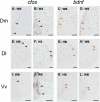Neurobiology of Wild and Hatchery-Reared Atlantic Salmon: How Nurture Drives Neuroplasticity
- PMID: 30254575
- PMCID: PMC6141658
- DOI: 10.3389/fnbeh.2018.00210
Neurobiology of Wild and Hatchery-Reared Atlantic Salmon: How Nurture Drives Neuroplasticity
Abstract
Life experiences in the rearing environment shape the neural and behavioral plasticity of animals. In fish stocking practices, the hatchery environment is relatively stimulus-deprived and does not optimally prepare fish for release into the wild. While the behavioral differences between wild and hatchery-reared fish have been examined to some extent, few studies have compared neurobiological characteristics between wild and hatchery-reared individuals. Here, we compare the expression of immediate early gene cfos and neuroplasticity marker brain-derived neurotrophic factor (bdnf) in telencephalic subregions associated with processing of stimuli in wild and hatchery-reared Atlantic salmon at basal and 30 min post (acute) stress conditions. Using in situ hybridization, we found that the expression level of these markers is highly specific per neuronal region and affected by both the origin of the fish, and exposure to acute stress. Expression of cfos was increased by stress in all brain regions and cfos was more highly expressed in the Dlv (functional equivalent to the mammalian hippocampus) of hatchery-reared compared to wild fish. Expression of bdnf was higher overall in hatchery fish, while acute stress upregulated bdnf in the Dm (functional equivalent to the mammalian amygdala) of wild, but not hatchery individuals. Our findings demonstrate that the hatchery environment affects neuroplasticity and neural activation in brain regions that are important for learning processes and stress reactivity, providing a neuronal foundation for the behavioral differences observed between wild and hatchery-reared fish.
Keywords: Atlantic salmon; bdnf; cfos; fish stocking; immediate early gene; in situ hybridization; neuroplasticity.
Figures






References
-
- Araki H., Schmid C. (2010). Is hatchery stocking a help or harm? Aquaculture 308 S2–S11. 10.1016/j.aquaculture.2010.05.036 - DOI
-
- Broglio C., Martín-Monzón I., Ocaña F., Gómez A., Durán E., Salas C., et al. (2015). Hippocampal pallium and map-like memories through vertebrate evolution. J. Behav. Brain. Sci. 5 109–120. 10.4236/jbbs.2015.53011 - DOI
LinkOut - more resources
Full Text Sources
Other Literature Sources

